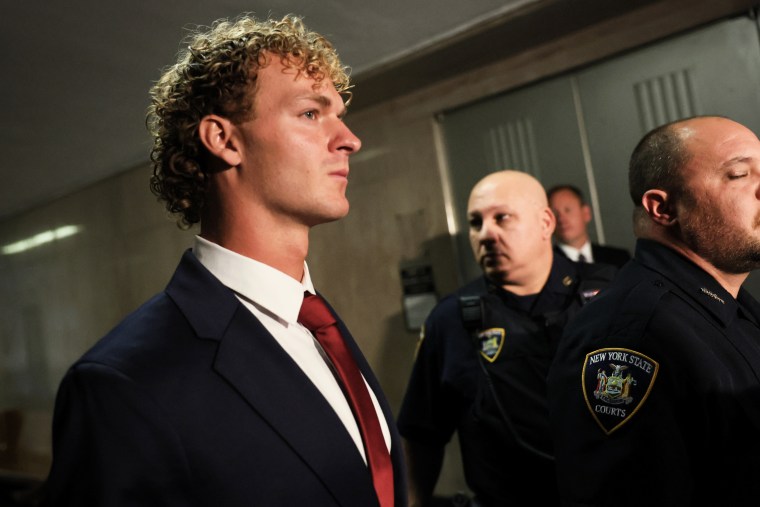The Daniel Penny Subway Trial: A Nation Watches

Let’s face it, folks—the Daniel Penny Subway Chokehold Trial has gripped the nation in a way few legal cases do. It’s not just about one incident on a subway train; it’s about the broader questions of self-defense, excessive force, and the role of bystanders in moments of crisis. This trial is forcing all of us to take a hard look at what happens when fear meets force in public spaces. So, let’s dive into the details, break it down, and try to understand what’s really going on.
From the charges against Penny to the arguments presented by both the prosecution and defense, this trial has layers upon layers of complexity. And let’s not forget the societal impact it’s having. So, buckle up—here’s everything you need to know about this high-stakes case.
Table of Contents
Read also:Celebrity Power How Stars Are Transforming The World Of Crypto Gambling
- The Subway Incident That Changed Everything
- The Charges: What Exactly Is Daniel Penny Facing?
- The Prosecution's Case: Was It Excessive Force?
- The Defense's Perspective: A Matter of Self-Defense
- Eyewitness Accounts: What Did the Bystanders See?
- What’s Next for Daniel Penny?
- Who Are the Key Players in This Drama?
- Public Outrage and the Call for Justice
- The Great Debate: Self-Defense or Excessive Force?
- Final Thoughts: What Does This Mean for the Future?
The Subway Incident That Changed Everything

Alright, here’s what went down. On a quiet day in May 2023, a New York City subway car became the stage for a tragedy that would shake the nation. Jordan Neely, a homeless man, began behaving erratically, shouting that he was hungry and thirsty. Some witnesses say he made threatening gestures, and others claim he was just a man in need of help. Enter Daniel Penny, a 24-year-old former Marine, who decided to intervene. Now, let’s be clear—Penny says he acted to protect the other passengers, but the situation quickly escalated. He restrained Neely in a chokehold, holding him down for several minutes. By the time it was over, Neely had tragically passed away. The incident was captured on video, and that footage has become Exhibit A in this trial.
The Charges: What Exactly Is Daniel Penny Facing?
Daniel Penny isn’t just facing public scrutiny—he’s facing serious legal charges. Specifically, he’s been charged with second-degree manslaughter. Now, manslaughter, in New York law, means causing someone’s death without malice or premeditation but under circumstances that show recklessness or negligence. The prosecution argues that Penny’s decision to use a chokehold—a potentially deadly move—was reckless and directly led to Neely’s death. They say Penny crossed the line from self-defense to excessive force, and they’re out to prove it. On the flip side, Penny’s defense team insists he acted out of fear for his safety and the safety of others. It’s a battle of perspectives, and the jury is in the middle of it.
The Prosecution's Case: Was It Excessive Force?

The prosecution’s argument is simple but powerful: Penny used excessive force. Assistant District Attorney Dafna Yoran argues that Penny should have known better than to apply a chokehold, a move that can quickly turn deadly. Medical experts have testified that Neely’s death was directly caused by the chokehold, which the prosecution says proves their point. Witnesses, including those who filmed the incident, say Penny continued the chokehold even after Neely stopped resisting. This, they argue, shows that Penny’s actions were reckless, not defensive. The prosecution’s job is to convince the jury that Penny’s response was out of line with the situation he faced.
The Defense's Perspective: A Matter of Self-Defense
But wait, the defense has its own story to tell. Led by attorney Thomas Kenniff, they argue that Penny acted in self-defense. Penny himself testified that Neely’s erratic behavior made him fear for his safety, especially given Neely’s history of mental health issues and homelessness. The defense also highlights Penny’s military training, suggesting that his actions were guided by his knowledge of restraint techniques. They’re asking the jury to consider whether Penny’s response was reasonable under the circumstances. Their case hinges on convincing the jury that Penny wasn’t trying to hurt Neely—he was trying to protect everyone on that subway car.
Read also:Top Casino Games With The Best Winning Odds
Eyewitness Accounts: What Did the Bystanders See?
The bystanders on that subway train have become key players in this trial. One of the most critical pieces of evidence is the video footage recorded by Ivette Rosario, a passenger who captured the entire incident. That video has been played and replayed, shaping public perception of what happened. Eric Gonzalez, another passenger who tried to intervene, testified about his concern for Neely’s well-being during the struggle. But not all witnesses agree. Some defense witnesses have disputed the severity of Neely’s behavior, arguing that Penny’s actions were justified. It’s a game of he-said, she-said, and the jury is tasked with sorting it all out.
What’s Next for Daniel Penny?
As the trial moves forward, everyone’s asking the same question: What’s the verdict going to be? There are a few possibilities here. Penny could be convicted of manslaughter, which would likely mean prison time. Or, the jury could decide that Penny was acting in self-defense, leading to an acquittal. It all comes down to how credible the witnesses are and whether the jury believes Penny’s actions were motivated by genuine fear. If the jury thinks Penny overreacted, he could face significant legal consequences. But if they believe he was trying to protect others, this could be seen as a tragic but justifiable incident.

Bob Woodruff’s Journey: Net Worth, Career Success, And Advocacy
Amy Adams Net Worth 2024: The Story Behind Her Success
Sharyn Alfonsi's Net Worth 2024: A Closer Look At Her Wealth, Career, And Financial Achievements


